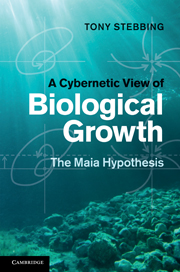Book contents
- Frontmatter
- Contents
- Foreword by Ernest Naylor
- Preface: ‘A fragment of a possible world’
- Acknowledgements
- 1 Introduction
- 2 Growth unlimited: blooms, swarms and plagues
- 3 Self-regulating systems: from machines to humans
- 4 The wealth of homeodynamic responses
- 5 A cybernetic approach to growth analysis
- 6 A control mechanism for Maia
- 7 The three levels of adaptation
- 8 Population growth and its control
- 9 Hierarchy: a controlled harmony
- 10 History of hormesis and links to homeopathy
- 11 Maian mechanisms for hormesis and catch-up growth
- 12 Cellular growth control and cancer
- 13 Human overpopulation
- 14 Our finite Earth
- 15 The Maia hypothesis and anagenesis
- Glossary
- Further reading
- References
- Index
10 - History of hormesis and links to homeopathy
Published online by Cambridge University Press: 10 January 2011
- Frontmatter
- Contents
- Foreword by Ernest Naylor
- Preface: ‘A fragment of a possible world’
- Acknowledgements
- 1 Introduction
- 2 Growth unlimited: blooms, swarms and plagues
- 3 Self-regulating systems: from machines to humans
- 4 The wealth of homeodynamic responses
- 5 A cybernetic approach to growth analysis
- 6 A control mechanism for Maia
- 7 The three levels of adaptation
- 8 Population growth and its control
- 9 Hierarchy: a controlled harmony
- 10 History of hormesis and links to homeopathy
- 11 Maian mechanisms for hormesis and catch-up growth
- 12 Cellular growth control and cancer
- 13 Human overpopulation
- 14 Our finite Earth
- 15 The Maia hypothesis and anagenesis
- Glossary
- Further reading
- References
- Index
Summary
All things are poison and nothing is without poison, only the dose permits something to be not poisonous.
ParacelsusEverything is poisonous, nothing is poisonous, it is all a matter of dose.
Claude BernardTHE ORIGINS OF HORMESIS
Between 1421 and 1423 great exploratory fleets sailed from China; hundreds of junks crewed by many thousands of men set out from Nanching. Gavin Menzies, in his book 1421, vividly describes how the captains and their fleets literally explored the world, riding the great ocean currents, making discoveries that have long been attributed to later explorers. They circumnavigated the globe in great voyages that took two years and more to complete. By that time, Chinese culture was scientifically advanced and capable of making silk, brass, gunpowder and porcelain. They were also very knowledgeable about medicine, minerals and metals.
The crews enjoyed a rich and varied diet from the cultivated plants and animals kept on board the huge junks. Menzies records that they killed bugs and insects with arsenic but, remarkably, used the same poison to promote the growth of plants and silkworms. They had discovered that arsenic, while toxic at higher concentrations, also had stimulatory and beneficial effects on growth at lower concentrations. They might have assumed this to be a specific property of arsenic, but we now know that stimulation due to low concentrations of toxic substances is a general phenomenon. This discovery has been made repeatedly over the centuries for many toxic agents and a wide range of animals and plants.
- Type
- Chapter
- Information
- A Cybernetic View of Biological GrowthThe Maia Hypothesis, pp. 234 - 265Publisher: Cambridge University PressPrint publication year: 2010



